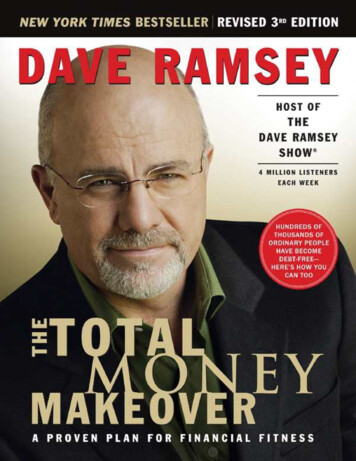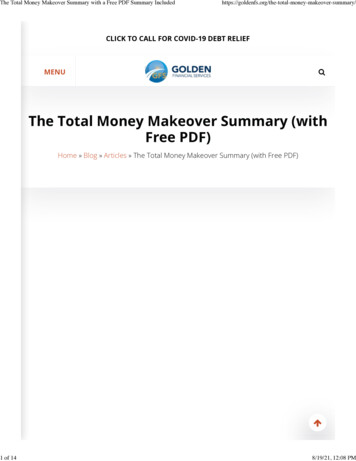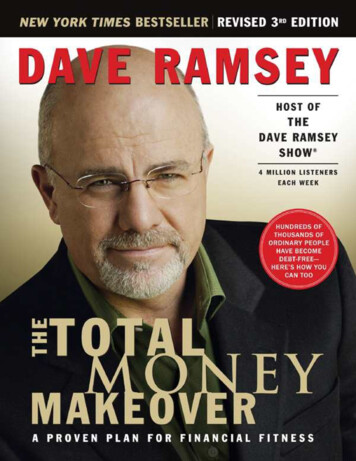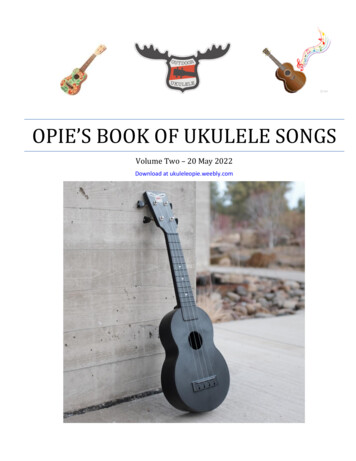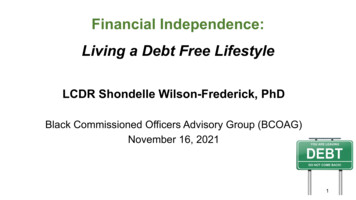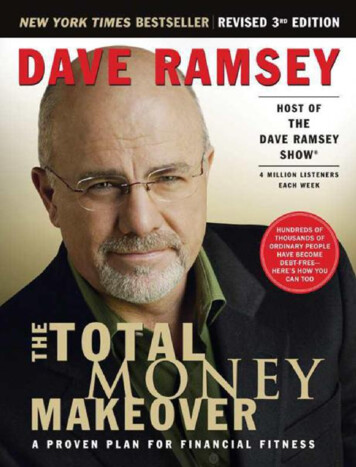
Transcription
TheTOTAL MONEYMAKEOVER
Other Books from Dave RamseyThe Total Money Makeover WorkbookThe Total Money Makeover Spanish Edition(La Transformación Total de su Dinero)Financial Peace RevisitedFinancial Peace PlannerFoundations in Personal Finance(High-school Curriculum)Tranquilidad Financiera(Spanish edition of Financial Peace )More Than EnoughMore Than Enough PlannerLife Lessons with Junior(Children’s Series)
TheTOTAL MONEYMAKEOVERA Proven Plan for Financial FitnessDave Ramsey
2003, 2007, 2009 by Dave RamseyAll rights reserved. No portion of this book may be reproduced, stored in a retrieval sy stem, ortransmitted in any form or by any means—electronic, mechanical, photocopy, recording,scanning, or other—except for brief quotations in critical reviews or articles, without the priorwritten permission of the publisher.Published in Nashville, Tennessee, by Thomas Nelson. Thomas Nelson is a trademark ofThomas Nelson, Inc.Thomas Nelson, Inc. titles may be purchased in bulk for educational, business, fund-raising, orsales promotional use. For information, please e-mail SpecialMarkets@ThomasNelson.com.Scripture quotations noted NKJV are from THE NEW KING JAMES VERSION. 1979,1980, 1982 by Thomas Nelson, Inc., Publishers. Used by permission. All rights reserved.Scripture quotations noted CEV are from THE CONTEMPORARY ENGLISH VERSION. 1995 by the American Bible Society . Used by permission.Scripture quotations marked NRSV are from the NEW REVISED STANDARD VERSION ofthe Bible. 1989 by the Division of Christian Education of the National Council of theChurches of Christ in the U.S.A. All rights reserved.ISBN 978-1-59555-216-7 (SE)ISBN 978-1-59555-078-1 (2009 edition)Library of Congress Cataloging-in-Publication DataRamsey , Dave.The total money makeover : a proven plan for financial fitness / Dave Ramsey .p. cm.ISBN 978-0-7852-8908-1 (2007 edition)1. Finance, Personal. 2. Debt. I. Title.
HG179.R31563 2003332.024'02—dc212003014115Printed in the United States of America09 10 11 12 13 WC 5 4 3 2 1
To my beautiful wife, Sharon, who walked arm in arm with me through a Total MoneyMakeover—I love you, honey.To the superstars all across America who have had the courage to face the person in themirror, the culture, their family, and even their coworkers as they “lived like no one elseso later they could live like no one else.” You who have courageously had a Total MoneyMakeover of the heart and wallet are the real superstars.To the Dave Ramsey team and the Thomas Nelson team for tireless hours on this project tomake this material available to everyone across this great land.
ContentsIntroductionWhat This Book Is NOTFlying Turkeys and Skinny Dipping1. The Total Money Makeover Challenge2. Denial:I’m Not That Out of Shape3. Debt Myths:Debt Is (Not) a Tool4. Money Myths:The (Non) Secrets of the Rich5. Two More Hurdles:Ignorance and Keeping Up with the Joneses6. Save 1,000 Fast:
Walk Before You Run7. The Debt Snowball:Lose Weight Fast, Really8. Finish the Emergency Fund:Kick Murphy Out9. Max imize Retirement Investing:Be Financially Healthy for Life10. College Funding:Make Sure the Kids Are Fit Too11. Pay Off the Home Mortgage:Be Ultrafit12. Build Wealth Like Crazy:Arnold Schwarzedollar, Mr. Universe of Money13. Live Like No One ElseMeet The Winners ofThe Total Money Makeover ChallengeAbout the AuthorBudgeting Forms
Index
IntroductionRead the stories of the lives changed by this book! As a matter of fact, Irecommend you skip through the book reading all the stories first. They willinspire you to read all the way through and actually do the Proven Plan toFinancial Fitness.Many years ago I was given a calling: to show people the truth about debtand money and to give them the hope and tools necessary to set themselvesfree financially. First, I did that with a few speaking engagements and a smallself-published book titled Financial Peace. Lat er Financial Peace waspublished by a New York publisher and became our first New York Timesbestseller. I began doing a small local radio show that has now grown to morethan 450 stations and millions of listeners that tune in weekly. We startedteaching a thirteen-week class called Financial Peace University, which hashad over 1 million families attend. Then came The Total Money Makeover.I am positive that personal finance is 80 percent behavior and only 20percent head knowledge. Our concentration on behavior—realizing that mostfolks have a good idea of what to do with money but not how to do it—hasled us to a different view of personal finance. Most financial people make themistake of trying to show you the numbers, thinking that you just don’t getthe math. I am sure that the problem with my money is the guy in my mirror.If he will behave, he can make the money thing work. The math of wealthbuilding is not rocket science; it is simple—but you have to DO IT!So the proven Total Money Makeover plan I teach has become verysuccessful not because I have found the secrets of the rich. Not because I hadsome revelation that no one else has ever had about credit cards. Not because Iam the only one with a “ Debt Snowball” plan. Instead, this proven plan ishaving a national impact because I have realized that to change your moneything, you have to change. You have to change your life. When you changeyour life, you will get out of debt, give, and invest at an unbelievable rate.When you read the stories in this book, you will read not about mathematics,
or magic systems, but about changed lives. You will read about transformedmarriages and relationships. Because when you change your life, you reallychange your life.So when Mike Hyatt, the president and CEO of Thomas NelsonPublishers, brought me the concept for a Total Money Makeover book, Ibecame very excited. I became excited because I knew this book would inspirereaders to take immediate action through a simple, step-by-step process thatcould only lead to life-changing results. Hope—the light at the end of thetunnel, that is, not an oncoming train—is a very powerful force. The TotalMoney Makeover has given HOPE to hundreds of thousands of families. Thisbook has given them hope to win, and that hope has caused them to takeaction and claim ultimate victory over their financial struggles and worries—and to actually win! The number of people that I meet across this nation whotell me this is the first book of any kind they have read in ten years isstaggering. The Total Money Makeover is a book for everyone. It is for highincome earners, as I am. And it is for someone beginning at the bottom,which is where I once was.You are about to read about a process, a proven plan, to win. You will findthe plan to be very simple yet very inspiring. The principles are not mine. Istole them all from God and your grandmother. The principles are commonsense, which isn’t so common anymore. The plan is mine—and I’m nogenius—created by simply observing literally millions of lives with whom Ihave interacted through radio, TV, books, classes, the Internet, e-mail,podcasts, and our Live Events. I have successfully bottled common senseabout money into a plan that anyone can do. And millions are!A couple of decades ago, when I first started talking about these principles,I knew they had helped my wife, Sharon, and me survive going broke andbegin to prosper. The first hundred times I spoke on money, I wasn’t asconfident of the principles as I am now. Nowadays I look into the eyes of agazillion people who have followed this plan and experienced, as we did,excitement, hope, and gratitude. I am so thankful that I have not only giventhem a proven plan but have also inspired them to change their family tree.
I am so confident in The Total Money Makeover principles and this processthat I cannot stand it when someone doesn’t get it. Because I am soconvinced my plan will work for everyone, my answers to the same questionswill never change. By recognizing and identifying some basic truths andeveryday common sense, I have convinced millions of people to change theirlives—to have a Total Money Makeover. Are you next?
Read thisBEFORE You BuyThe Book!What This Book Is NOTI know it may be hard for you to believe, but I get a lot of hate mail andcriticism. This book and what I have or have not said in it has generated a lotof negativity and name-calling. That is fun. Not fun because I set out to offendor because I love reading the nasty things people often say. It is fun becausethe negativity means two things: One, for some people we are touching anerve that needs to be touched in order for them to change their lives, andtwo, I am actively and passionately pursuing the truth. (Aristotle once said“ To avoid criticism say nothing, do nothing, and be nothing.”) I can’t helpmillions of people change their lives by saying nothing, doing nothing, andbeing nothing. So I take the anger, the criticism, and even the hate mail asencouragement.My publisher suggested I “ answer my critics.” I will pass. Mygrandmother used to say, “ Those convinced against their will are of the sameopinion still.” However, I do not want you, dear reader, to be misled. So it isappropriate that I tell you what this book is NOT. That way you can decidewhether or not to spend your hard-earned money on it.This Book Is NOT Sophisticated or ComplicatedIf you are looking for a detailed, in-depth guide to investing, you have notfound it. If you are looking for boring academic chirping that will put you tosleep using words only to support the author’s ego, you have not found it.What I have discovered is that some of the most profound and life-changingtruths you will ever discover are very simple.
In our culture we worship the complicated and the sophisticated. If youknow how to work your DVD player, you may not have a good one. In thefinancial world we have been taught to be arrogant snobs. Some believe thatsimple ideas are not profound, that instead, simple ideas are for the “ littlepeople.” That is a false and arrogant notion. I have met with thousands ofmillionaires, and in almost every case they keep their investing and moneyphilosophies very uncomplicated. Just this week I was discussing investingand business structure with a friend of mine whose net worth is over twentymillion dollars, and his words to me were, “ I always keep it simple andclean.” Only the financial goobers like to complicate things for the sake ofjustifying their existence or justifying how much they paid for their education.Please do not look here for a detailed guide to set up an estate plan or a deeptheory on investing. That is not what I do. What I do is help peopleunderstand and act on time-honored truths about money that will truly changeyour whole life.This Book Is NOT Something That Has Never Been SaidThere are many great money authors out there today, and there are even morein our past. Very little that you read in this book will be something thatsomeone else has not written or said. We often say on our radio show that wegive the same financial advice your grandmother would, only we keep ourteeth in. I suggest you read a lot of different people, as I do. I have inventedvery little in this area of money. What I have done is packaged the timehonored information into a process that is doable and has inspired millions ofpeople to act on it. Most of us know what to do; we just have trouble doingit. How do you lose weight? Exercise more and eat less. I know that, and yetI bought and read a couple of books on the subject while I took action, and Ilost thirty pounds. Did the authors of those books tell me big ideas that weregroundbreaking? No, they simply gave me an action plan and somesupporting details to what I already knew had to be done. Welcome to myworld.
This Book Is NOT Going to Mislead You on InvestmentReturnsThere are several ignorant people in our country today on the returns offeredby investing well. Ignorance is not lack of intelligence; it is simply “ notknowing.” Sadly, many intelligent but ignorant people seem to think thatmaking a 12 percent rate of return on your money in a long-term investment isimpossible. And that if I state that there is a 12 percent rate of return available,then I have lied to you or misled you.I recommend good growth stock-type mutual funds in this book as a longterm investment and dare to state that you should make 12 percent on yourmoney over time. The supporting data for that bold statement can be found bylooking at the historical averages of the S&P 500 index. Widely regarded asthe best single gauge of the US equities market, the Standard & Poor’s 500 isan index with 500 of the largest companies in leading industries of the USeconomy. The S&P 500 has averaged 11.67 percent per year for the lasteighty plus years, as of this writing. This includes the big drop in the 2008market. Most experts and anyone who has had even one finance class agreethat the S&P 500 is a great statistical measure of stock market returns. This issuch a standard, or bellwether, that virtually every stock fund will show youits returns in comparison to the S&P 500.I purchased a Growth and Income Stock Mutual Fund many years ago, thatI still invest in, and it has averaged 12.03 percent per year since 1934 (75years as of this writing). I bought another last week that has averaged over13.9 percent per year since 1973, as of this writing. And yet another withaverage annual returns of 12.01 percent since 1984, and another averaging12.39 percent since 1973, and yet another averaging 11.72 percent since 1952.Any decent broker with the heart of a teacher can, in his or her sleep, lead youto funds with long track records averaging over 12 percent. So don’t letanyone tell you that you can’t predict a 12 percent rate when you areconsidering investments for ten years or longer.
This Book Is NOT Written by Someonewith No Academic CredentialsI seldom list my formal academic credentials because, honestly, I don’t thinkthey are important. I have met so many broke people with financial credentialsthat I almost think it discredits me to have had formal training. Yes, I have adegree in finance. Yes, I have been or am licensed in real estate, insurance, andinvestments. Yes, I do have many of the stupid letters to put after my name.But the thing that qualifies me most to teach about money is that I have donestupid with zeros on the end. I have been there, done that. I have a PhD in DU-M-B. So I know what it is like to be scared and scarred. I know what it islike to have my marriage hanging by a thread because of financial stress. Iknow what it is like to have my hopes and dreams crushed by my own stupiddecisions. That qualifies me uniquely to teach and to love hurting people.The other huge qualifier is that I used the principles I teach to personallybuild wealth. My wife and I have truly lived this book. The things we teachare not theory—they work!But the teaching credential that I am most sure of and which furtherqualifies me is the hundreds of thousands of stories of people across Americabeing set free by this book. This stuff simply works. So don’t take financialadvice from broke people.This Book Is NOT Politically CorrectI stated earlier that personal finance is 80 percent behavior. To properly viewbehavior and to understand how to change behavior intelligently, we mustconsider several things. Behavior intelligently viewed takes into account theemotional, the relational, the family history, the socioeconomic impacts, andthe spiritual. To ignore any of these while discussing behavior change aboutmoney is incomplete and very naive. So I openly discuss the spiritual in thisbook. As a Christian, I include some Bible verses. This is not a “ Christian”book, and it for sure isn’t a Bible study on the subject of money. But this is a
book about a “ Proven Plan to Financial Fitness” that my team and I havedeveloped over two decades, and that plan includes addressing the spiritualissues surrounding money. So I upset both sides—those who don’t like itbecause I include spiritual thoughts in my teachings and those who don’tbelieve my writing is spiritual enough. Either way, you have been warned.This Book Is NOT WrongDon’t confuse extreme confidence with arrogance. I am extremely confidentthat this material works, because millions of people have benefited from it. Iam not arrogant because I realize I am not personally responsible for any of thelives changed. The stuff I teach is the truth, and those principles areresponsible for changing lives. But I always answer the same questions withthe same answers even though sometimes folks think their situation may bedifferent. It isn’t different. The principles stand, and they work every time.This Book Is NOT the Same As My Other BooksWhen we took on The Total Money Makeover project, we had to answer aquestion of integrity: Could we honestly go into the market and ask myreaders to buy another book that said the same thing? I couldn’t in goodconscience do that. Financial Peace has sold nearly 2 million copies as of thiswriting, so did I really need to write another book? I came to the conclusionthat there was a distinct difference in the two projects. Financial Peace is“ what to do with money.” It is a great textbook for commonsense moneymanagement. So how is The Total Money Makeover different? It is more thana “ what to do” book—it is a “ how to do it” plan. This is a process book.We are aiming at carefully weaving inspiration and information together into astep-by-step plan. Yes, you will find in this book a lot of the same subjectsalong with many of the same principles I discuss in my other books, but thisbook is different in that it is a process-driven work.
If you are looking for a ton of new information because you are someonewho only gathers facts and figures, then you will be disappointed. If you arelooking to engage this money thing head on, you will love this book. ManyFinancial Peace readers have told me that The Total Money Makeover gavelegs to the concepts to which they had been introduced, so they were thankfulto read it as well. But again, don’t look for some big revelation or chapters ofnew principles.This Book Is NOT Getting Any Complaints or Criticism . . . from people who do it. I have never had someone write me saying, “ I goton a budget, got out of debt, got on the same page with my spouse, builtwealth—and I HATE IT.” For those who have followed this plan anddiscovered a new life of financial freedom, their lives have been changedforever! Wouldn’t you like to experience the same transformation? You canbe the next success story people hear about. You can have a Total MoneyMakeover starting today!
Flying Turkeys and Skinny DippingWhen I was a child, my grandmother—a second-grade schoolteacher who alsotaught drama—used to sit me on her knee and read to me. She read with greatenthusiasm and a lot of drama.One of the children’s stories she read to me was about the three little pigs.One built his house out of straw, one out of twigs, and one out of brick. Youknow the story—the two who built their houses “ quick and dirty” goofed off,partied, and made fun of the bricklayer because he was taking too much timeand effort to do it right. Of course, when the wind and rains came, the twoshort-term thinkers ended up moving in with their brother. Why? Because hehad prepared well enough to weather the storms. The other two found theirlives completely blown apart.Economic Storms, Real OnesA huge economic storm hit America—and the rest of the world—in 2008. Aswith all strong storms, the only houses that survived were the ones that werebuilt well, on a solid foundation. The rest were blown over. Companies whohad been built well survived; those who hadn’t are now history. Many oncegreat businesses abandoned their strong foundations by investing in bad, highrisk investments and taking on mountains of debt. Sadly, most of thosecompanies are now history or are owned by someone else.What happened? Well, this is not a textbook on economics, so we won’tdissect every detail. However, it is instructive to your Total Money Makeoverto look at the event to learn our private lessons. The 30,000-foot view thatyou would get from an airplane might look like this:Broke people in serious financial trouble borrowed money from greedybankers at horrible terms and high interest rates to buy homes. The loans werenot prime (good) loans, so they were accurately called SUBprime loans. That
just means these mortgages were less than good. Duh.This rip-off lending has always been done, but never on such a large scale.In an effort to make more profits to keep their stock prices up, banks andinvestment bankers began to buy these loans in bulk—and they bought lots ofthem. What was unthinkable in the investment community just a few yearsearlier became common practice.Formerly legitimate, upstanding, major banks and investment bankersessentially became loan sharks using very sophisticated financial instruments.For years, the mortgage industry had packaged good mortgages together andsold them as bonds. You have probably heard of Fannie Mae Bonds. Thatused to refer to a group of good Fannie Mae mortgages that were wrappedtogether and sold as unit, or bond. During this period of stupidity, however,the SUBprime (bad) loans were packaged together and sold as bonds—a lot ofthem.We live in a cause-and-effect world. What you sow, you will reap. In ashocking turn of events, the broke people didn’t pay their mortgage payments(he says sarcastically). This, for some unknown reason, seemed to surprise thegreedy bankers. Surprise! Broke people can’t pay ridiculous house payments!Go figure.The big problem, however, was scale. A lot of broke people didn’t paytheir payments. So, foreclosure numbers began to rise rapidly. In some boommarkets, where the real estate prices had shot up artificially high, theforeclosures began bringing home prices down. And down and down.With values dropping so low, relatively secure and responsible homeowners started to get in trouble too. Fear broke out on Wall Street, and stockprices started dropping. By the time the fear got to Washington, it hadbecome a full-blown panic. And once the panic got to the news media, it hadbecome all-out hysteria.Every day, American consumers watched the hysteria play out ontelevision. With their 401(k) and home values dropping, they wisely decided
this was not a good time to keep spending like a drunken Congressman.When we stopped buying stuff at a breakneck speed, the economy slowed,and businesses began hurting everywhere. Companies who were deeply indebt and cash-poor began to die. A LOT of businesses vanished almostovernight. People stopped buying washers and dryers, so the washer-and-dryermanufacturer started laying people off, and unemployment rose. This, ofcourse, just made the cycle go around again, forcing real estate and stockprices even lower.Good News, Bad NewsThe good news is that we are recovering and will continue to recover. Somelearned the painful lessons on a private, individual level; others learned theeconomic lessons on a more widespread, national level. Many people didn’tlearn anything at all.The great news is that, for some of you, this event was your GreatDepression, emotionally speaking. The Great Depression permanentlychanged the way many people handled their money. If you have a grandfatheror great-aunt who was an adult during that time, he or she likely has acompletely different way of looking at debt, saving, and giving than mostpeople of other generations. That is because your loved one has experience.And as my pastor says, “ a man with an experience is not at the mercy of aman with an opinion.”I went broke twenty years ago, and that experience changed my life. I haveapplied the principles of this book to my life for the past two decades, sowhen this storm hit in 2008, I was just a spectator. It didn’t hurt me a bit. Ihave actually come out ahead by buying real estate at great prices andinvesting heavily in the stock market while both were down.I’ve spent the last twenty years trying to get people to live these TotalMoney Makeover principles. A lot of people have listened, so when the winds
blew and the storms came, they were just as ready as I was. They had a strongfoundation.Flying TurkeysWhat does all this mean for your Total Money Makeover? The first lesson ofthis economic storm is that your financial process and principles must work ingood times and in bad times—otherwise, they don’t work. Our economy hadbeen so good for so long that really stupid ideas had been working on theshort term. That fooled people into believing that stupid had become smart.In other words, stupid hadn’t been stress tested in quite a while; when itfinally was, it came up looking, well, stupid.When times are booming, you can do dumb things with money, getsloppy, and take huge risks without realizing it. I have heard it said this way:“ Even a turkey can fly in a tornado.” People were running around, buyingthings they couldn’t afford with money they didn’t have, to impress peoplethey didn’t even like; and they were doing it in record numbers. Worse, theyseemed to get away with it!They were like the two little pigs with straw and twig homes: As long asthe sun was shining, life was a party, and the pig with brick seemed kind ofnerdy, or overly conservative, or even fanatical. But when their stupid theorieswere stress tested, their houses fell.Jim Collins, one of America’s greatest business writers, has a book outcalled How the Mighty Fall. In this book, he discusses the five stages ofdecline when a business fails, or falls. There is a great application here for ournation’s economy and for your life and mine.Collins says the first stage of decline is marked by hubris. Pride andarrogance, mixed with a false notion of invincibility, lead the mighty to takehuge, ridiculous risks. In our case, that would be borrowing lots of moneyand not saving any because “ my job is ‘stable.’ I can afford the ‘easy
payments’ with my ‘job.’”This hubris causes sloppiness and denial of risk. Hey, that sounds like metwenty years ago—right before I went broke. I had been taught a group ofmyths—lies—that I accepted as truth about money. I thought the rules of riskand restraint didn’t apply to me because I was so smart. That led me to builda house of cards that fell the first time there was a light breeze, much less areal storm.Here’s the lesson: Just because you see a turkey flying in a tornado doesn’tmean turkeys can fly. Just because some wild-eyed theory of investing,borrowing, and living without cash reserves works in good times doesn’tmean you can survive a storm. Remember, your ways of handling money haveto work in good times and in bad.Skinny-DippingWarren Buffett has a great saying: “ When the tide goes out, you can tell whowas skinny-dipping.” I have taught for years that if you have a bad map, youwill be late for—or completely miss—the party. The principles that you buildyour life on will determine your level of success. If you plan your marriagearound a bad map, or bad set of assumptions, then it will likely fail. If youhave all the good intentions in the world, but build your financial house onbad ideas, it will fall. I personally experienced this a long time ago. With thislast recession, many more Americans are discovering that their theories aboutmoney and their assumptions about how money works were wrong. And theydiscovered they were wrong the hard way—through pain.Overspending that doesn’t feel like overspending because things are goingwell is still overspending. Using debt to invest in real estate or the stockmarket and the hope of a quick return will cause you to go broke the minutethe market turns. Chasing the next get-rich-quick scam, like the lottery, orinvesting in gold, will always bring you pain. Hiring someone else—likesome debt-settlement company—to fix your life virtually never works.
The myths—lies spread by our culture—that were covered in this book’sfirst two editions have all been proven by this economic downturn. If you livethe way we teach in this book, you will prosper in good times and in badtimes.I have a friend that we will call Chris. Chris told me an interesting story inthe middle of the latest recession that illustrates what I am pointing out toyou. For thirteen years, Chris worked for a large corporation whose name youwould recognize. He started his Total Money Makeover about seven yearsago. When I saw him two years ago, he ran up to me with a big smile andbig hug to proudly proclaim that he was “ DEBT FREE!!” including hishome. He had absolutely no debt, and had saved 38,000 in his emergencyfund.When I saw him again a year later, he had another fun story to share withme. It seems that he and his boss had become best friends over the years thatthey worked together. That week, his friend—his boss—came into his office,with blood drained from his face and his lip quivering, saying, “ I don’t knowhow to tell you this, but corporate is making me lay you off.” Chris jumpedup from his chair, ran around the desk, gave his friend a big hug, and said,“ Cool! How much is the severance?”The company gave him more than 70,000 in severance, and he is nowstarting his own business—something he has wanted to do for years. Hewasn’t stressed, but instead saw only opportunity, because he was ready. Asof this writing, he will make almost double his old salary with his newbusiness this year. Wow.However, most people live on the other side of the coin. When they getnews of a layoff, they have the blood drain from their faces and it is their lipsthat are quivering. If you have lost your job and are struggling, I am notpicking on you. I have seen hard times. But I want you to do what I did whenI faced pain brought on by my own stupid decisions and lack of preparation. Isaid very loudly, “ NEVER AGAIN!” Next time . . . well
Ramsey, Dave. The total money makeover : a proven plan for financial fitness / Dave Ramsey. p. cm. ISBN 978--7852-8908-1 (2007 edition) 1. Finance, Personal. 2. Debt. I. Title. . free financially. First, I did that with a few speaking engagements and a small self-published book titled Financial Peace. Later Financial Peace was



